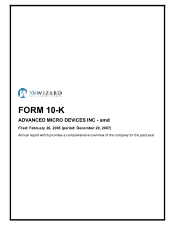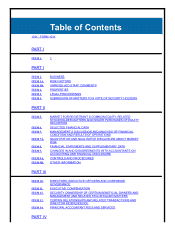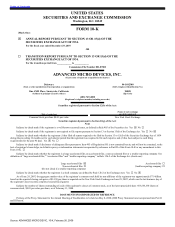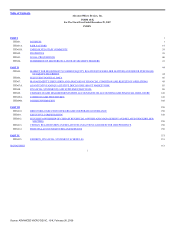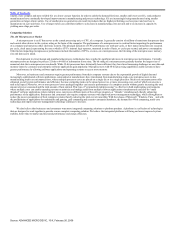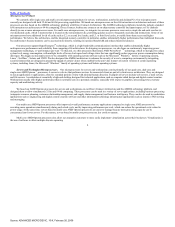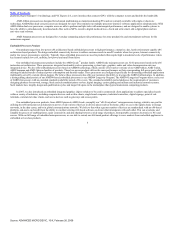AMD 2007 Annual Report Download - page 8
Download and view the complete annual report
Please find page 8 of the 2007 AMD annual report below. You can navigate through the pages in the report by either clicking on the pages listed below, or by using the keyword search tool below to find specific information within the annual report.
Table of Contents
smaller, more complex and more reliable ICs at a lower cost per function. In order to satisfy the demand for faster, smaller and lower-cost ICs, semiconductor
manufacturers have continually developed improvements in manufacturing and process technology. ICs are increasingly being manufactured using smaller
geometries on larger silicon wafers. Use of smaller process geometries can result in products that are higher performing, use less power and cost less to
manufacture on a per unit basis. Use of larger wafers can contribute further to a decrease in manufacturing costs per unit and to an increase in capacity by
yielding more chips per wafer.
Computing Solutions
The x86 Microprocessor Market
A microprocessor is an IC that serves as the central processing unit, or CPU, of a computer. It generally consists of millions of transistors that process data
and control other devices in the system, acting as the brain of the computer. The performance of a microprocessor is a critical factor impacting the performance
of a computer and numerous other electronic systems. The principal indicators of CPU performance are work-per-cycle, or how many instructions are executed
per cycle, clock speed, representing the rate at which a CPU’s internal logic operates, measured in units of hertz, or cycles per second, and power consumption.
Other factors impacting microprocessor performance include the number of CPUs, or cores, on a microprocessor, the bit rating of the microprocessor, memory
size and data access speed.
Developments in circuit design and manufacturing process technologies have resulted in significant advances in microprocessor performance. Currently,
microprocessors are designed to process 32-bits or 64-bits of information at one time. The bit rating of a microprocessor generally denotes the largest size of
numerical data that a microprocessor can handle. While 32-bit processors have historically been sufficient, they have faced increasing challenges as new data and
memory-intensive consumer and enterprise software applications gain popularity. Microprocessors with 64-bit processing capabilities enable systems to have
greater performance by allowing software applications and operating systems to access more memory.
Moreover, as businesses and consumers require greater performance from their computer systems due to the exponential growth of digital data and
increasingly sophisticated software applications, semiconductor manufacturers have transitioned from manufacturing single-core microprocessors to also
manufacturing multi-core microprocessors, where multiple processor cores are placed on a single die or in a single processor. Multi-core microprocessors offer
enhanced overall system performance and efficiency because computing tasks can be spread across two or more processing cores each of which can execute a
task at full speed. Moreover, two or more processor cores packaged together can increase performance of a computer system without greatly increasing the total
amount of power consumed and the total amount of heat emitted. This type of “symmetrical multiprocessing” is effective in both multi-tasking environments
where multiple cores can enable operating systems to prioritize and manage tasks from multiple software applications simultaneously and also for “multi
threaded” software applications where multiple cores can process different parts of the software program, or “threads,” simultaneously thereby enhancing
performance of the application. Businesses and consumers also require computer systems with improved power management technology, which allows them to
reduce the power consumption of their computer systems thereby reducing the total cost of ownership. With the release of Microsoft® Windows Vista ™ and with
the proliferation of applications for multimedia and gaming, grid computing and extensive enterprise databases, the demand for 64-bit computing, multi-core
technology and improved power management technology continues to increase.
We also believe that businesses and consumers want more integrated computing solutions or platform products. A platform is a collection of technologies
that are designed to work together to provide a more complete computing solution. We believe that integrated platforms will bring end users improved system
stability, better time-to-market and increased performance and energy efficiency.
3
Source: ADVANCED MICRO DEVIC, 10-K, February 26, 2008

